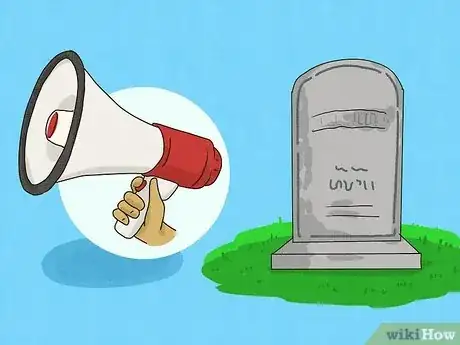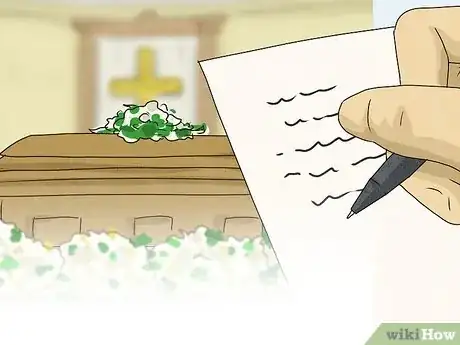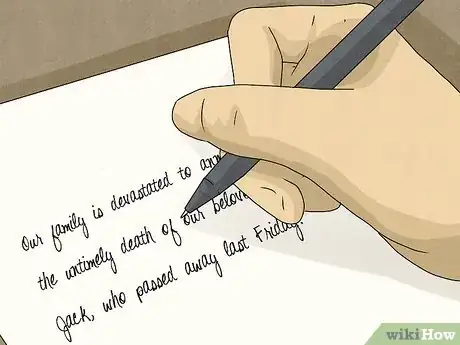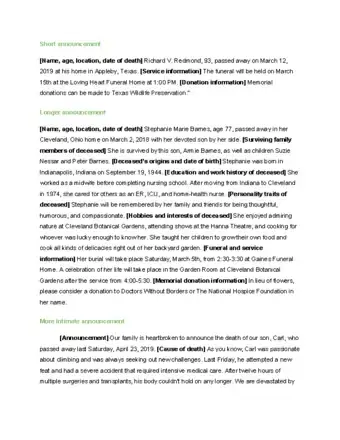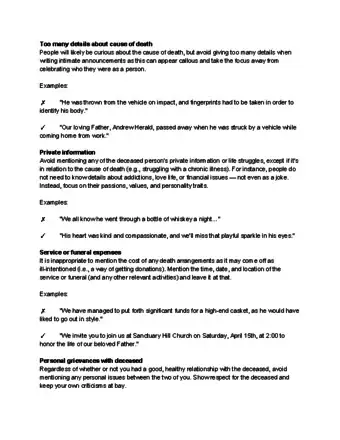This article was co-authored by David I. Jacobson. David I. Jacobson is the founder of Chicago Jewish Funerals, an independent Jewish owned funeral provider that evolved into two funeral homes in the Chicagoland area. With over 30 years of experience serving families, David is a leading expert on Kavod Hamet, the Jewish traditions of honoring and respecting the dead. David is an active funeral director that serves people planning and in need of funerals, lecturing to congregations, community groups, and schools extensively about the values of the Jewish funeral as well as the dying process and the value of one’s legacy.
This article has been viewed 222,941 times.
The death of a loved one is an emotional time. The last thing on your mind might be writing a death announcement to publish in a newspaper or online. Fortunately, writing a death announcement can be simple. At a minimum, you should provide the name of your departed loved one, the date of death, and when a memorial service will be held. If you choose, you can write a more detailed death announcement either for the newspaper or to announce the passing to family and friends.
Steps
Drafting a Basic Announcement
-
1Decide whether to write a basic announcement. A basic announcement is always appropriate if you feel too overwhelmed to write anything else. You can keep your announcement to a few sentences. However, there may be other situations where you want to write a short announcement.
- You’re publishing an announcement in a newspaper. There may be a word limit, so you may want to keep the announcement as short as possible.
- You want to invite people to the funeral but don’t know them too well. You can limit the amount of information you share with people you don’t know. You can send a more intimate announcement to friends and family.
-
2Announce the death. You can begin your announcement with a simple sentence stating who has died and the date of their passing. You may also choose to include their age. Often, you will make this announcement as a family.
- For example, you can write, “The Smith family announces with great sadness the loss of their beloved mother, Eileen, age 81, on September 1, 2016.”[1]
- Here is alternate wording: “The Smith family announces the passing of their mother, Eileen, who died peacefully on September 1, 2016.”
- Another wording: “Eileen Smith. 81. Our beloved mother passed away on September 1, 2016.”[2]
Advertisement -
3State whether you will have a service. You might hold a mass or a funeral—or both. You should state when the event will be held and where.
- For example, you can write: “A service will be held on September 8, 2016, at 8:00 pm at the synagogue in Plains, TN.”[3]
- If you’re having a funeral, then write: “A funeral service will be held on September 8, 2016 at 2:30 pm at United Methodist Church, Any City.”
-
4Identify where people can send donations. Those in grief might want to contribute money in the memory of your loved one. Make sure to mention any foundation or scholarship fund they can contribute to.[4]
- For example, you can write, “Memorial donations in Eileen’s name may be made to the American Cancer Society.”
Writing a Longer Announcement
-
1Announce your loved one's passing. As with a basic notice, you should begin with the person’s name and the date they died. Include the age if you want.
- For example, you can write: “Ken Jones, 68, died on Sunday, July 17, 2016 in Any City, USA.”[5]
-
2Identify birth details. In a longer death announcement, it is appropriate to identify the date of birth as well as the loved one’s parents. You don’t have to include this information, but you may want to.
- For example, you can write, “He was born June 22, 1948 in Los Angeles, California, to Kevin and Charlotte Jones.”[6]
-
3Explain the deceased’s education. A longer announcement lets you provide details about a person’s accomplishments, such as the schools they attended.[7] Mention any that seem appropriate. People who went to school with your loved one might notice the school name first and your loved one second.
- For example, you can write, “He attended Middle Town Community High School and the University of Michigan.”
-
4Name surviving and predeceased family members. Provide some details about who your loved one was married to and the children they had. Also mention whether their spouse or children predeceased them.
- For example, you can write, “In 1970 he married Carol Johnson and is survived by his wife and two daughters, Jean and Joan.”[8]
- If your loved one is predeceased by a spouse, you can write: “He is survived by his two daughters, Jean and Joan, and pre-deceased by his wife Carol, whom he married in 1970.”
-
5Include professional information and awards. With a longer announcement, you can remind the reader of your loved one’s professional accomplishments.[9] Mention highlights and any award they received. Remember that this isn’t a resume, so stick to a sentence or two.
- For example, you can write, “Ken served for 35 years in various government jobs, rising to the office of City Hall Manager, where he served from 2000-2008. Upon his retirement, he received the Outstanding Citizen Award from Any City’s mayor.”
-
6Provide some personal details. Your loved one touched many people’s lives, and you can use a longer announcement to mention one or two details about their personality.[10] This kind of detail can bring a smile to the face of whoever reads the announcement and remembers the deceased.
- For example, you might write: “Ken’s colleagues and family will miss his unique sense of humor, which saw him dress up in costume on holidays, whether as Santa or as the Easter Bunny.”
-
7Include funeral service details. State the location, date and time. Identify whether it is a memorial service, mass, or other religious observance.
- For example, you can write: “A memorial service will be held at Castle Funeral home on July 27, 2016.”[11]
-
8Direct people to where they can make a donation. Your loved one might have belonged to an organization that accepts charitable contributions, or they may have contributed to a favorite charity. You can direct people to donate in your loved one’s name.
- For example: “Donations may be made in Ken’s name to the city’s Recreation Fund.”
Sending an Intimate Notice to Friends and Family
-
1Identify when an intimate announcement is appropriate. You might want to share more details about the death, such as the cause of death. Often, people want to share this information with close friends or family in an email or letter.
- An intimate death announcement allows you to adopt a more informal tone. You can address the reader as “you.”
-
2Announce the passing. You can identify when your loved one died. Because the announcement is informal, you might only want to state the day of the week instead of the date.
- For example, you can write: “Our family is devastated to announce the untimely death of our beloved uncle, Jack, who passed away last Friday.”[12]
-
3Provide other details. You can include any information that you want in an intimate death announcement, including details that you would include in a longer death announcement, such as the following:
- surviving family members
- professional accomplishments and education
- personal details (hobbies, quirks, etc.)
- donations or charities people can contribute to
Help Writing a Death Announcement
Expert Q&A
-
QuestionHow do you write a death announcement?
 David I. JacobsonDavid I. Jacobson is the founder of Chicago Jewish Funerals, an independent Jewish owned funeral provider that evolved into two funeral homes in the Chicagoland area. With over 30 years of experience serving families, David is a leading expert on Kavod Hamet, the Jewish traditions of honoring and respecting the dead. David is an active funeral director that serves people planning and in need of funerals, lecturing to congregations, community groups, and schools extensively about the values of the Jewish funeral as well as the dying process and the value of one’s legacy.
David I. JacobsonDavid I. Jacobson is the founder of Chicago Jewish Funerals, an independent Jewish owned funeral provider that evolved into two funeral homes in the Chicagoland area. With over 30 years of experience serving families, David is a leading expert on Kavod Hamet, the Jewish traditions of honoring and respecting the dead. David is an active funeral director that serves people planning and in need of funerals, lecturing to congregations, community groups, and schools extensively about the values of the Jewish funeral as well as the dying process and the value of one’s legacy.
Funeral Home Director Different newspapers have their own way of writing death announcements. However, you pay for it, so you can do it differently if you wish.
Different newspapers have their own way of writing death announcements. However, you pay for it, so you can do it differently if you wish. -
QuestionWhat is an announcement letter?
 Community AnswerAnnouncement letters are made to inform people of a situation or something important. In this case, the letter would be to inform people of a death.
Community AnswerAnnouncement letters are made to inform people of a situation or something important. In this case, the letter would be to inform people of a death.
References
- ↑ http://brandongaille.com/8-death-announcement-wording-ideas/
- ↑ https://www.everplans.com/articles/death-notice-templates-and-obituary-templates
- ↑ http://brandongaille.com/8-death-announcement-wording-ideas/
- ↑ https://www.everplans.com/articles/death-notice-templates-and-obituary-templates
- ↑ https://www.everplans.com/articles/death-notice-templates-and-obituary-templates
- ↑ https://www.everplans.com/articles/death-notice-templates-and-obituary-templates
- ↑ https://www.everplans.com/articles/death-notice-templates-and-obituary-templates
- ↑ https://www.everplans.com/articles/death-notice-templates-and-obituary-templates
- ↑ https://www.everplans.com/articles/death-notice-templates-and-obituary-templates
- ↑ https://www.everplans.com/articles/death-notice-templates-and-obituary-templates
- ↑ https://www.everplans.com/articles/death-notice-templates-and-obituary-templates
- ↑ http://www.writeexpress.com/announ42.html
- ↑ David I. Jacobson. Funeral Home Director. Expert Interview. 14 July 2020.
About This Article
To write a death announcement, begin with a simple sentence saying who has died and the date of their passing. For example, write “The Smith family announces with great sadness the loss of their beloved mother, Eileen, aged 81, on Saturday.” In the second sentence, say when the service will take place. If you want to ask for memorial donations in the name of the deceased person, include details of where the donations should go. For a longer death notice, add sentences about when the person was born and what they did during their life. Additionally, name other family members who have survived the deceased. For tips on how to send a notice to close friends or family, keep reading.

